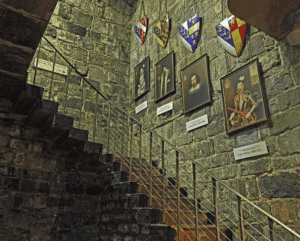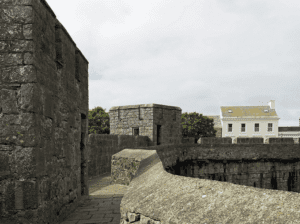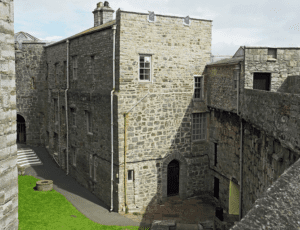Castle Rushen, located in the ancient capital of the Isle of Man, was once the residence of the Kings and Lords of Mann. When built it was a statement of power, guarding the entrance to the Silverburn River. Its white limestone keep dominated the surrounding countryside and would have been visible from most of the south of the island. It is still one of the best preserved medieval castles in Europe.
The Vikings settled the Isle of Man from the C9th and established a power base in the west of the island on “St Patrick’s Isle.”:http://wasleys.org.uk/eleanor/man/central/patrick_isle/index.html By the 1200s, with increasing attention from England and Scotland, the centre of power moved to the south of the island.
The building of Castle Rushen is attributed to the Norse King Reginald who built a square stone keep surrounded by a bailey and ditch on a dry spit of land to the east of the Silverburn. The land to the west was very boggy making it a good defensive site. The kitchens, domestic buildings and stables were in the bailey. Gradually a settlement grew up under the protection of Castle Rushen. The Norse kings divided their time between Peel Castle and Castle Rushen until 1242, when they moved permanently to Castle Rushen.
Castle Rushen was developed by successive rulers between the C13th-C16th. It is a large and complex site. The oldest part of the Castle is the keep which was rebuilt in 1333.
After the death of the last Norse King in 1265, the island was fought over and changed hands between England and Scotland several times. In 1333, the island was granted to William, First Earl of Salisbury, who was a childhood friend and courtier to Edward III. He was responsible for the rebuilding of the keep, adding a third store, new gatehouse with a portcullis and a drawbridge on the north side.
He added additional towers on the sides of the keep. When William died a year later, his son became King of Mann. He was responsible for building the curtain wall which surrounds the keep. This had firing platforms for cannons which were becoming increasingly important for defence. He also built the outer gatehouse with a barbican and ditch round the outside of the curtain wall.
In the early C16th, a stone faced bank or glacis was added to the south side of the castle to give extra protection from enemy cannon fire.
In 1405, Henry IV gave the Isle of Man to one of his staunch supporters, Sir John Stanley. The island became a hereditary right of the Stanley Family on payment of two peregrine falcons to all succeeding English monarchs on their coronation. The peregrine falcon still supports one side of the coat of arms of the Isle of Man.The Stanleys were one of the wealthiest families in England and their rule lasted until 1736. Henry VIII conferred the title Earl of Derby on Thomas Stanley. On his death, his grandson assumed the title Lord of Mann, although the title King of Mann was still used in ceremonial proceedings until the 1600s. Most of the Stanleys spent little time on the island, leaving government and defence to their officials and soldiers, although Tynwald met in the castle grounds.
By the C16th, accommodation in the keep was poor, and in 1580, Henry Stanley, fourth Earl of Derby, ordered a new building on the curtain wall near the gatehouse. Called Derby House, this was used as accommodation for the Lord of Mann and his household. The ground floor was the servants quarters with the Earl and his guests using the upper two floors.
James Stanley, the tenth Earl of Derby died in 1736 with no heirs. The title of Lord of Mann passed to his cousin, the second Duke of Atholl. The third Duke of Atholl sold the right to the British Government and the island became a dependency of the British Crown, with the monarch as Lord of Mann.
Derby House became the home of the Lieutenant General, the Lord of Mann’s representative on the island, until they moved to Lorne House and then Douglas. Tynwald met here until it moved to the George Inn and later, in 1821, to the newly built Old house of Keys. The building was used as a courtroom until 1991.
The rest of the castle became a prison in the early 1700s and this is the reason the castle has survived. From 1765, fines from prisoners were no longer used for the maintenance of the castle and this led to serious structural deterioration. In 1816 there was major work undertaken on the keep to improve conditions. Between 1849-1864, Castle Rushen was also used as an asylum for the mentally insane. Warders were reported as spending much of their time taking Victorian sightseers round the prison
Conditions eventually became so bad, that an inspection in 1885 by the Chairman of the Commissioners for Prisons in England and Wales recommended a new prison be built. This opened in Douglas in 1891.
Lord Raglan, the Lieutenant Governor instigated the restoration of Castle Rushen in 1902 as a heritage and tourist attraction. The Victorian additions were removed and it was restored to externally to its medieval appearance. It was formally handed back to the Isle of Man Government by George V in 1928. It is now in the care of Manx National Trust.
There are more information about Castletown “here.”:http://wasleys.org.uk/eleanor/man/south/castletown/index.html
DISABLED ACCESS
There is wheelchair access into the inner bailey, courtyard keep and the ground floor of the keep. Access to the rest of the castle is via spiral staircases or a wide stone staircase. There are acccessible toilets.
There is detailed information about access “here.”:https://manxnationalheritage.im/wp-content/uploads/2018/06/Castle-Rushen-Access-Guide-2018.pdf










